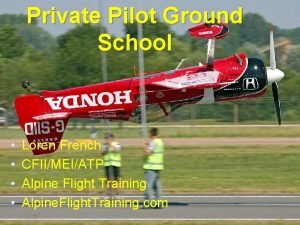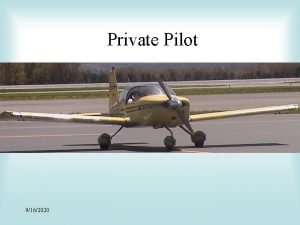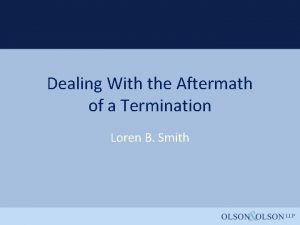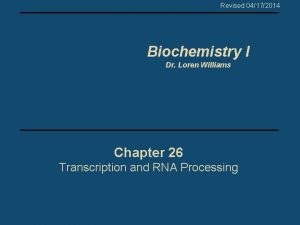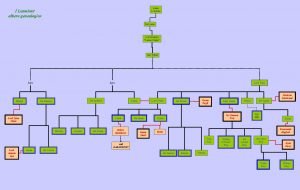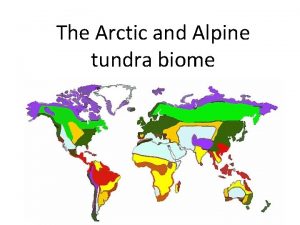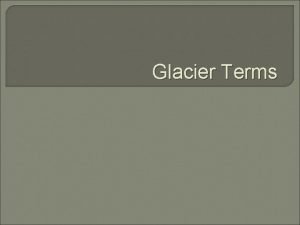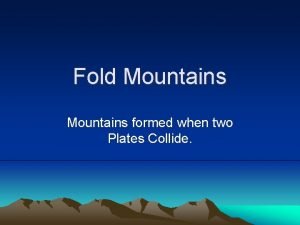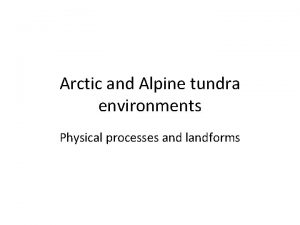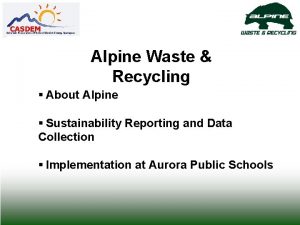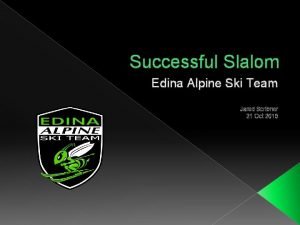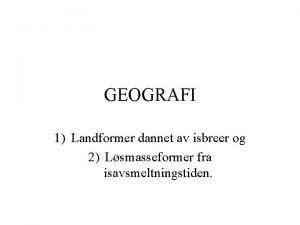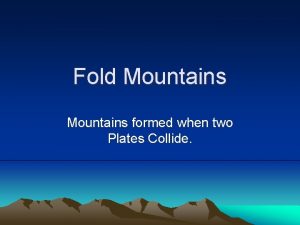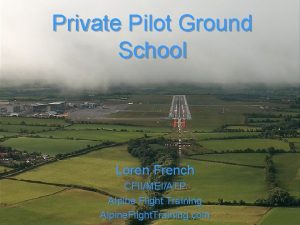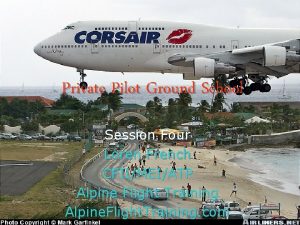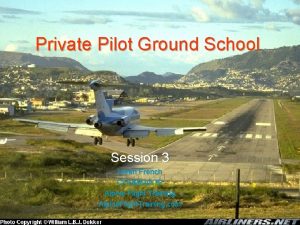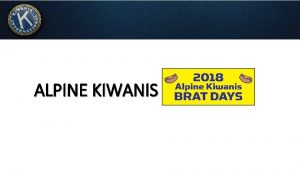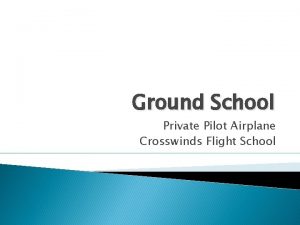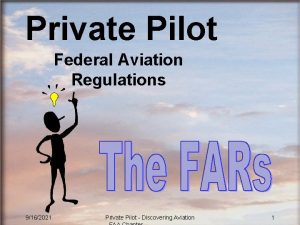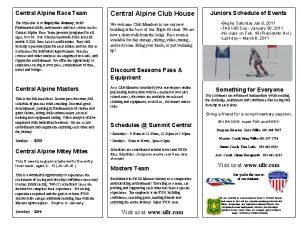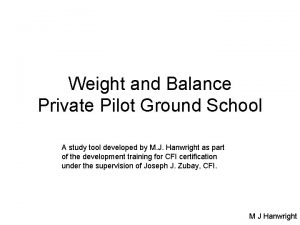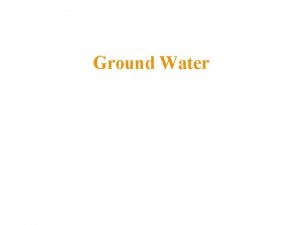Private Pilot Ground School Loren French CFIIMEIATP Alpine






























- Slides: 30

Private Pilot Ground School • • Loren French CFII/MEI/ATP Alpine Flight Training Alpine. Flight. Training. com

Engines Instruments and Systems

Magnetic Compass and Compass errors • During flight, magnetic compasses can be considered accurate only during straightand-level flight at constant airspeed. • The difference between direction indicated by a magnetic compass not installed in an airplane and one installed in an airplane is called deviation. • Magnetic fields produced by metals and electrical accessories in an airplane disturb the compass needles.

Magnetic Compass and Compass errors • In the Northern Hemisphere, acceleration/deceleration error occurs when on an east or west heading. Remember ANDS: Accelerate North, Decelerate South. • A magnetic compass will indicate a turn toward the north during acceleration when on an east or west heading. • A magnetic compass will indicate a turn toward the south during deceleration when on an east or west heading. • Acceleration/deceleration error does not occur when on a north or south heading.

Magnetic Compass and Compass errors • • In the Northern Hemisphere, compass turning error occurs when turning from a north or south heading. A magnetic compass will lag (and at the start of a turn indicate a turn in the opposite direction) when turning from a north heading. – 1) If turning to the east (right), the compass will initially indicate a turn to the west and then lag behind the actual heading until your airplane is headed east (at which point there is no error). – 2) If turning to the west (left), the compass will initially indicate a turn to the east and then lag behind the actual heading until your airplane is headed west (at which point there is no error). • • • A magnetic compass will lead or precede the turn when turning from a south heading. Turning errors do not occur when turning from an east or west heading. These errors diminish as the acceleration/deceleration or turns are completed.

Pitot-Static System • 1. 2. 3. The pitot-static system is a source of pressure for the Altimeter. Vertical-speed indicator. Airspeed indicator. • The pitot tube provides impact (or ram) pressure for the airspeed indicator only. • When the pitot tube and the outside static vents or just the static vents are clogged, all three instruments mentioned above will provide inaccurate readings. • If only the pitot tube is clogged, only the airspeed indicator will be inoperative.

Airspeed indicators have several color-coded markings The white arc is the full flap operating range. 1) The lower limit is the power-off stalling speed with wing flaps and landing gear in the landing position (VS 0). 2) The upper limit is the maximum full flaps-extended speed (VFE). The green arc is the normal operating range. 1) The lower limit is the power-off stalling speed in a specified configuration (VS 1). This is normally wing flaps up and landing gear retracted. 2) The upper limit is the maximum structural cruising speed (VNO) for normal operation. The yellow arc is airspeed which is safe in smooth air only. 1) It is known as the caution range. The red radial line is the speed that should never be exceeded (VNE). 1) This is the maximum speed at which the airplane may be operated in smooth air (or under any circumstances). The most important airspeed limitation which is not color coded is the maneuvering speed (VA). – – The maneuvering speed is the maximum speed at which full deflection of aircraft controls can be made without causing structural damage. It is usually the maximum speed for flight in turbulent air.

Altimeter • Altimeters have three hands (e. g. , as a clock has the hour, minute, and second hands; ). The three hands on the altimeter are the • – – – • • 10, 000 -ft. interval (short needle). 1, 000 -ft. interval (medium needle). 100 -ft. interval (long needle). Altimeters are numbered 0 -9. To read an altimeter, – – – First, determine whether the short needle points between 0 and 1 (110, 000), 1 -2 (10, 000 -20, 000), or 2 -3 (20, 000 -30, 000). Second, determine whether the medium needle is between 0 and 1 (0 -1, 000), 1 and 2 (1, 000 -2, 000), etc. Third, determine at which number the long needle is pointing, e. g. , 1 for 100 ft. , 2 for 200 ft. , etc.

Types of Altitude • Absolute altitude is the altitude above the surface, i. e. , AGL. • True altitude is the actual distance above mean sea level, i. e. , MSL. It is not susceptible to variation with atmospheric conditions. • Density altitude is pressure altitude corrected for nonstandard temperatures. • Pressure altitude is the height above the standard datum plane of 29. 92 in. of mercury. Thus, it is the indicated altitude when the altimeter setting is adjusted to 29. 92 in. of mercury (also written 29. 92" Hg). • Pressure altitude and density altitude are the same at standard temperature. • Indicated altitude is the same as true altitude when standard conditions exist and the altimeter is calibrated properly. • Pressure altitude and true altitude are the same when standard atmospheric conditions (29. 92" Hg and 15°C at sea level) exist. • When the altimeter is adjusted on the ground so that indicated altitude equals true altitude at airport elevation, the altimeter setting is that for your location, i. e. , approximately the setting you would get from the control tower.

Setting the Altimeter • The indicated altitude on the altimeter increases when you change the altimeter setting to a higher pressure and decreases when you change the setting to a lower pressure. – • This is opposite to the altimeter's reaction due to changes in air pressure. The indicated altitude will change at a rate of approximately 1, 000 ft. for 1 in. of pressure change in the altimeter setting. – EXAMPLE: When changing the altimeter setting from 29. 15 to 29. 85, there is a 0. 70 in. change in pressure (29. 85 - 29. 15). The indicated altitude would increase (due to a higher altimeter setting) by 700 ft. (0. 70 x 1, 000).

Non Standard Temp/Pressure Since altimeter readings are adjusted for changes in barometric pressure but not for temperature changes, an airplane will be at lower than indicated altitude when flying in colder than standard temperature air when maintaining a constant indicated altitude. On warm days, the altimeter indicates lower than actual altitude.

Non Standard Temp/Pressure • Likewise, when pressure lowers en route at a constant indicated altitude, your altimeter will indicate higher than actual altitude until you adjust it. • Remember, when flying from high to low (temperature or pressure), look out below. • Low to high, clear the sky.

Gyroscopic Instruments Vacuum system

Gyroscopic Instruments Attitude Indicator (AI) • The attitude indicator, with its miniature aircraft and horizon bar, displays a picture of the attitude of the airplane. • The relationship of the miniature aircraft to the horizon bar is the same as the relationship of the real aircraft to the actual horizon. • The relationship of the miniature airplane to the horizon bar should be used for an indication of pitch and bank attitude, i. e. , nose high, nose low, left bank, right bank. • The gyro in the attitude indicator rotates in a horizontal plane and depends upon rigidity in space for its operation. • An adjustment knob is provided with which the pilot may move the miniature airplane up or down to align the miniature airplane with the horizon bar to suit the pilot's line of vision.

Gyroscopic Instruments Turn Coordinator • The turn coordinator shows the roll and yaw movement of the airplane. • It displays a miniature airplane which moves proportionally to the roll rate of the airplane. When the bank is held constant, the turn coordinator indicates the rate of turn. • The ball indicates whether the angle of bank is coordinated with the rate of turn.

Gyroscopic Instruments Turn Coordinator • The heading indicator is a gyro instrument which depends on the principle of rigidity in space for its operation. • Due to gyro precession, it must be periodically realigned with a magnetic compass.

Engine Temperatures • Excessively high engine temperature either in the air or on the ground will cause loss of power, excessive oil consumption, and excessive wear on the internal engine. • An engine is cooled, in part, by circulating oil through the system to reduce friction and absorb heat from internal engine parts. • Engine oil and cylinder head temperatures can exceed their normal operating range because of (among other causes) – – – • Operating with too much power Climbing too steeply (i. e. , at too low an airspeed) in hot weather Using fuel that has a lower-than-specified octane rating Operating with too lean a mixture The oil level being too low Excessively high engine temperatures can be reduced by reversing any of the above situations, i. e. , reducing power, climbing less steeply (increasing airspeed), using higher octane fuel, enriching the mixture, etc.

Engine Temperatures

• Constant speed Propeller The advantage of a constantspeed propeller (also known as controllable-pitch) is that it permits the pilot to select the blade angle for the most efficient performance. • Constant-speed propeller airplanes have both throttle and propeller controls. • The throttle controls power output, which is registered on the manifold pressure gauge. • The propeller control regulates engine revolutions per minute (RPM), which are registered on the tachometer. • To avoid overstressing cylinders, excessively high manifold pressure should not be used with low RPM settings. Manifold pressure is controlled by the Throttle (power) The Rpm is controlled by the prop lever

Engine Ignition system “Magneto” • One purpose of the dual-ignition system is to provide for improved engine performance. • The other is increased safety.

Carb Ice • • Carburetor-equipped engines are more susceptible to icing than fuel-injected engines. – The operating principle of float-type carburetors is the difference in air pressure between the venturi throat and the air inlet. – Fuel-injected engines do not have a carburetor. The first indication of carburetor ice on airplanes with fixed-pitch propellers and float-type carburetors is a loss of RPM. • Carburetor ice is likely to form when outside air temperature is between 20°F and 70°F and there is visible moisture or high humidity. • When carburetor heat is applied to eliminate carburetor ice in an airplane equipped with a fixed-pitch propeller, there will be a further decrease in RPM (due to the less dense hot air entering the engine) followed by a gradual increase in RPM as the ice melts.

Carb Heat • Carburetor heat enriches the fuel/air mixture, • Because warm air is less dense than cold air. • When the air density decreases (because the air is warm), the fuel/air mixture (ratio) becomes richer since there is less air for the same amount of fuel. • Applying carburetor heat decreases engine output and increases operating temperature.

Fuel Air Mixture • At higher altitudes, the fuel/air mixture must be leaned to decrease the fuel flow in order to compensate for the decreased air density, i. e. , to keep the fuel/air mixture constant. • If you descend from high altitudes to lower altitudes without enriching the mixture, the mixture will become leaner because the air is denser at lower altitudes. • If you are running up your engine at a high-altitude airport, you may eliminate engine roughness by leaning the mixture, • Particularly if the engine runs even worse with carburetor heat, since warm air further enriches the mixture.

Fuel Air Mixture

4 Stroke Principles

Abnormal Combustion • Detonation occurs when the fuel/air mixture explodes instead of burning evenly. • Detonation is usually caused by using a lower-thanspecified grade (octane) of aviation fuel or by excessive engine temperature. • This causes many engine problems including excessive wear and higher than normal operating temperatures. • Lower the nose slightly if you suspect that an engine (with a fixed-pitch propeller) is detonating during climbout after takeoff. This will increase cooling and decrease the engine's workload. • Pre-ignition is the uncontrolled firing of the fuel/air charge in advance of the normal spark ignition.

Aviation Fuel Practices • Use of the next-higher-thanspecified (octane) grade of fuel is better than using the next-lowerthan-specified grade of fuel. This will prevent the possibility of detonation, or running the engine too hot. • Filling the fuel tanks at the end of the day prevents moisture condensation by eliminating the airspace in the tanks. • In an airplane equipped with fuel pumps, the auxiliary electric fuel pump is used in the event the engine-driven fuel pump fails.

Fuel Systems Types of Fuel Systems 1. Gravity feed 2. Pump driven 3. Injected Fuel Injection

Engine starting • After the engine starts, the throttle should be adjusted for proper RPM and the engine gauges, especially the oil pressure, checked. • When starting an airplane engine by hand, it is extremely important that a competent pilot be at the controls in the cockpit. – (hand propping not allowed at WVFC) • Refer to your aircrafts POH for proper starting and operating techniques and concerns.

The End • • Loren French CFII/MEI/ATP Alpine Flight Training Alpine. Flight. Training. com
 Alpine flight training
Alpine flight training Rudder
Rudder What exception if any permits a private pilot
What exception if any permits a private pilot Loren isum
Loren isum Face shape step by step
Face shape step by step Loren brown attorney
Loren brown attorney Loren williams
Loren williams Loren williams
Loren williams Klod loren
Klod loren Loren lannister
Loren lannister Locatera
Locatera Aunt flossie's hats
Aunt flossie's hats Alpine biome
Alpine biome Tundra biome map
Tundra biome map World map showing tundra biome
World map showing tundra biome Glacier terms
Glacier terms Armorican fold mountains
Armorican fold mountains Tundra landforms
Tundra landforms Tundra carnivores
Tundra carnivores Alpine waste
Alpine waste Alpine vegetation
Alpine vegetation Www. alpineskihouse.com
Www. alpineskihouse.com Alpine ski house
Alpine ski house Alpine ski house
Alpine ski house Alpine fault simulation
Alpine fault simulation Mast ski team
Mast ski team Edina alpine ski team
Edina alpine ski team Landformer dannet av isbreer
Landformer dannet av isbreer Alpine commercial real estate broker
Alpine commercial real estate broker Alpine
Alpine Fold mountains definition
Fold mountains definition
